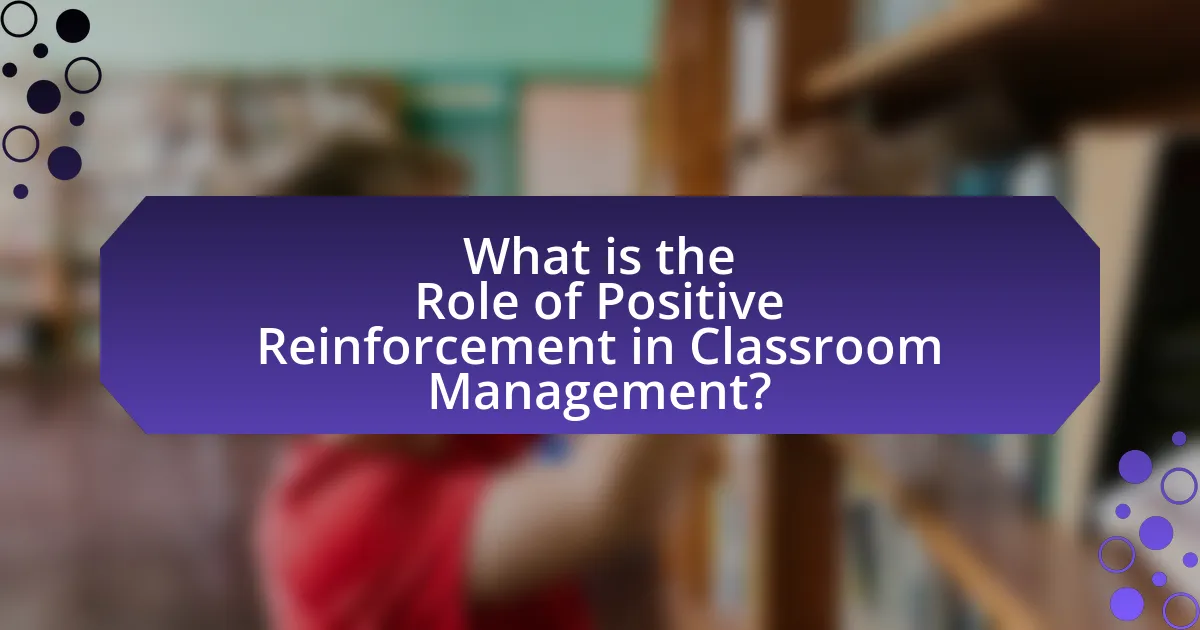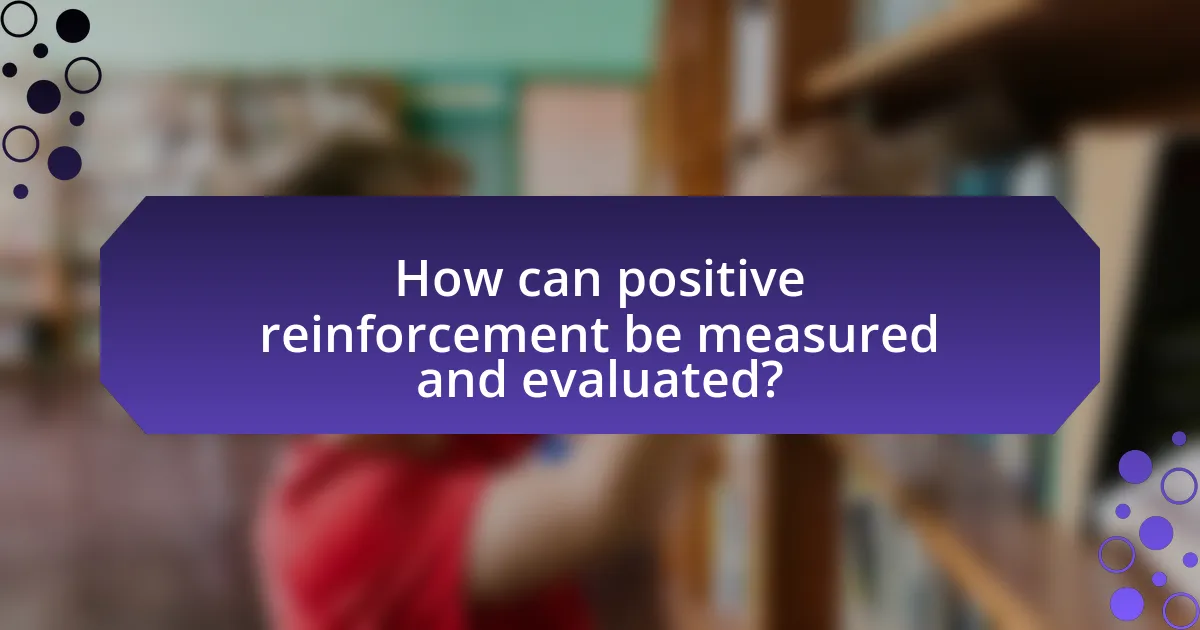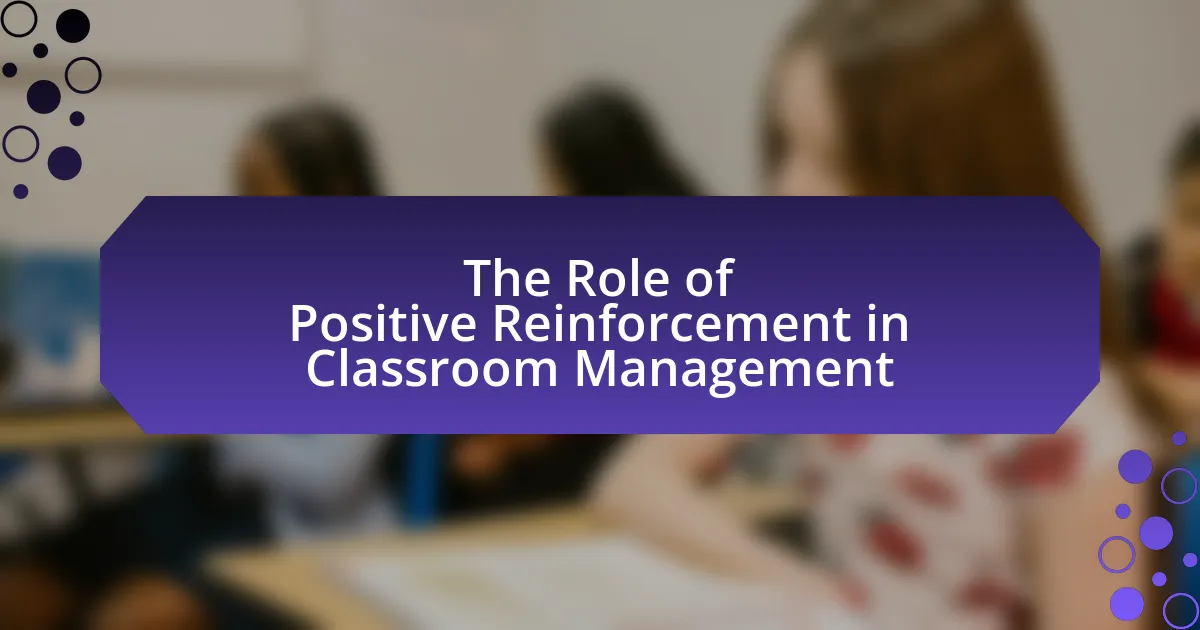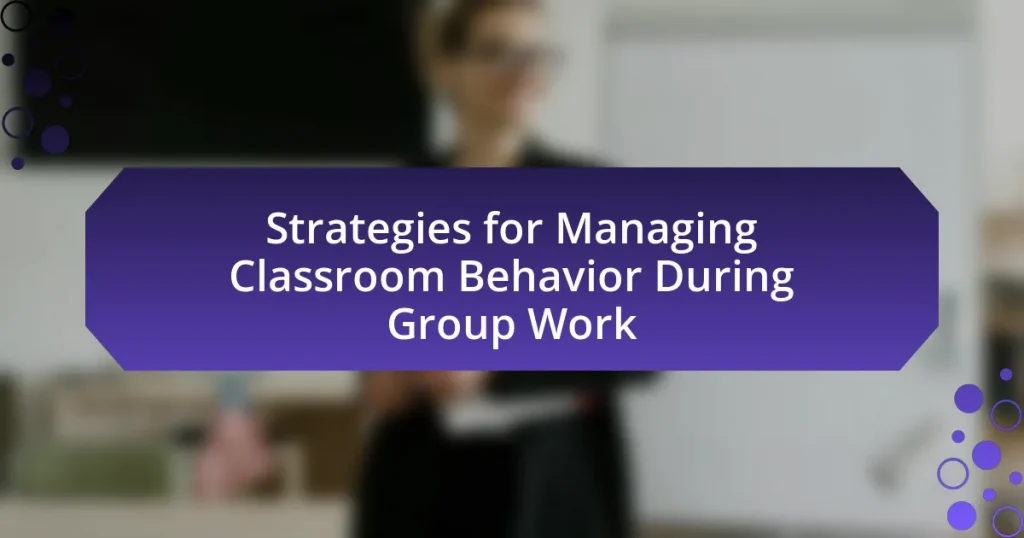The article focuses on the role of positive reinforcement in classroom management, highlighting its significance in encouraging desirable student behaviors. It discusses how positive reinforcement, through methods such as praise and rewards, enhances student motivation, engagement, and academic performance. Key principles of effective positive reinforcement, including immediacy and consistency, are outlined, along with strategies for implementation and potential challenges teachers may face. The article also differentiates positive reinforcement from negative reinforcement and emphasizes the importance of tailoring reinforcement to individual student needs for optimal effectiveness.

What is the Role of Positive Reinforcement in Classroom Management?
Positive reinforcement plays a crucial role in classroom management by encouraging desirable behaviors among students. When teachers use positive reinforcement, such as praise, rewards, or recognition, they create an environment that motivates students to engage in appropriate behaviors and academic efforts. Research indicates that positive reinforcement can lead to improved student behavior, increased motivation, and enhanced learning outcomes. For example, a study published in the Journal of Applied Behavior Analysis found that positive reinforcement strategies significantly reduced disruptive behaviors in classrooms, demonstrating their effectiveness in promoting a conducive learning atmosphere.
How does positive reinforcement influence student behavior?
Positive reinforcement significantly influences student behavior by increasing the likelihood of desired actions through rewards or positive feedback. When students receive praise, tokens, or other incentives for good behavior or academic achievements, they are more motivated to repeat those behaviors. Research indicates that positive reinforcement can lead to improved academic performance and enhanced classroom engagement, as evidenced by a study published in the Journal of Applied Behavior Analysis, which found that students who received positive reinforcement showed a 30% increase in on-task behavior compared to those who did not. This demonstrates that the strategic use of positive reinforcement can effectively shape and improve student behavior in educational settings.
What are the key principles of positive reinforcement?
The key principles of positive reinforcement include the use of rewards to increase desired behaviors, the immediacy of reinforcement following the behavior, and the consistency of reinforcement to strengthen the behavior over time. Positive reinforcement operates on the premise that behaviors followed by positive outcomes are more likely to be repeated. Research indicates that immediate reinforcement, such as praise or tangible rewards, enhances the likelihood of behavior repetition, as demonstrated in studies by Skinner (1953) on operant conditioning. Consistent application of reinforcement further solidifies the connection between the behavior and the positive outcome, making it a fundamental strategy in effective classroom management.
How does positive reinforcement differ from negative reinforcement?
Positive reinforcement involves adding a desirable stimulus to increase a behavior, while negative reinforcement entails removing an aversive stimulus to enhance a behavior. In positive reinforcement, rewards such as praise or tangible rewards encourage students to repeat desired behaviors, as evidenced by studies showing that students who receive positive feedback are more likely to engage in those behaviors again. Conversely, negative reinforcement focuses on the relief from unpleasant conditions, such as allowing a student to leave a stressful situation when they complete a task, which also promotes the likelihood of task completion in the future. Both methods aim to increase desired behaviors but do so through fundamentally different mechanisms.
Why is positive reinforcement important in educational settings?
Positive reinforcement is important in educational settings because it enhances student motivation and engagement. When educators use positive reinforcement, such as praise or rewards, it encourages desired behaviors and academic performance. Research indicates that students who receive positive reinforcement are more likely to participate actively in class and demonstrate improved learning outcomes. For instance, a study published in the Journal of Applied Behavior Analysis found that positive reinforcement significantly increased on-task behavior among students, leading to higher academic achievement. This evidence supports the effectiveness of positive reinforcement as a crucial strategy in classroom management.
What impact does positive reinforcement have on student motivation?
Positive reinforcement significantly enhances student motivation by increasing their engagement and willingness to participate in learning activities. When students receive positive feedback or rewards for their efforts, they are more likely to repeat those behaviors, leading to improved academic performance and a greater sense of self-efficacy. Research by Skinner (1953) on operant conditioning demonstrates that reinforcement strengthens desired behaviors, which is applicable in educational settings. Additionally, a study published in the Journal of Educational Psychology found that students who experienced consistent positive reinforcement showed higher motivation levels and better academic outcomes compared to those who did not receive such reinforcement.
How does positive reinforcement contribute to a positive classroom environment?
Positive reinforcement significantly contributes to a positive classroom environment by encouraging desired behaviors among students. When teachers acknowledge and reward positive actions, such as participation or cooperation, it increases the likelihood that these behaviors will be repeated. Research indicates that classrooms utilizing positive reinforcement strategies experience higher levels of student engagement and lower rates of disruptive behavior. For instance, a study published in the Journal of Positive Behavior Interventions found that implementing a positive reinforcement system led to a 30% decrease in classroom disruptions. This evidence supports the notion that positive reinforcement fosters a supportive atmosphere conducive to learning and collaboration.

What strategies can be used for effective positive reinforcement?
Effective positive reinforcement strategies include immediate feedback, specific praise, and tangible rewards. Immediate feedback ensures that the reinforcement is closely tied to the desired behavior, making it clear to the student what action is being rewarded. Specific praise, such as acknowledging a student’s effort or a particular achievement, reinforces the behavior more effectively than general comments. Tangible rewards, like stickers or extra playtime, can motivate students and create a positive association with the desired behavior. Research indicates that these strategies enhance student engagement and improve learning outcomes, as evidenced by studies showing that students who receive timely and specific reinforcement demonstrate higher levels of motivation and academic performance.
How can teachers implement positive reinforcement in their classrooms?
Teachers can implement positive reinforcement in their classrooms by consistently acknowledging and rewarding desired behaviors. This can be achieved through various methods such as verbal praise, tangible rewards like stickers or tokens, and special privileges. Research indicates that positive reinforcement increases student engagement and motivation, as evidenced by a study published in the Journal of Applied Behavior Analysis, which found that students who received positive reinforcement demonstrated improved academic performance and behavior. By integrating these strategies, teachers can create a supportive learning environment that encourages students to repeat positive behaviors.
What types of rewards are most effective for positive reinforcement?
Tangible rewards, social recognition, and intrinsic rewards are the most effective types of rewards for positive reinforcement. Tangible rewards, such as stickers or small prizes, provide immediate gratification and can motivate students to engage in desired behaviors. Social recognition, including praise or public acknowledgment, enhances self-esteem and encourages continued positive behavior. Intrinsic rewards, like the satisfaction of mastering a skill or achieving a personal goal, foster long-term motivation and a love for learning. Research indicates that a combination of these reward types can lead to improved student engagement and behavior management in classroom settings. For instance, a study by Deci, Koestner, and Ryan (1999) found that intrinsic motivation is significantly enhanced when students receive positive feedback, demonstrating the effectiveness of these reward types in educational environments.
How can teachers tailor positive reinforcement to individual student needs?
Teachers can tailor positive reinforcement to individual student needs by identifying each student’s unique motivations and preferences. For instance, some students may respond better to verbal praise, while others may prefer tangible rewards or additional privileges. Research indicates that personalized reinforcement strategies can enhance student engagement and motivation, as highlighted in a study by Deci, Koestner, and Ryan (1999) which found that tailored reinforcement increases intrinsic motivation. By observing student behaviors and soliciting feedback, teachers can effectively customize their reinforcement approaches, ensuring that each student feels valued and motivated to succeed.
What challenges might teachers face when using positive reinforcement?
Teachers may face several challenges when using positive reinforcement, including inconsistency in application, potential dependency on rewards, and difficulty in identifying appropriate reinforcers. Inconsistency can lead to confusion among students regarding expectations and desired behaviors, as reinforcement must be applied consistently to be effective. Additionally, students may become reliant on external rewards, which can undermine intrinsic motivation and lead to disengagement when rewards are not present. Furthermore, identifying suitable reinforcers can be challenging, as what motivates one student may not motivate another, requiring teachers to tailor their approach to individual needs. These challenges highlight the complexities involved in effectively implementing positive reinforcement strategies in classroom management.
How can teachers overcome resistance to positive reinforcement?
Teachers can overcome resistance to positive reinforcement by establishing a clear understanding of its benefits and consistently applying it in a supportive manner. Research indicates that when teachers explain the rationale behind positive reinforcement, students are more likely to accept and engage with it. For instance, a study published in the Journal of Educational Psychology found that students who received clear explanations about the purpose of rewards showed increased motivation and participation in classroom activities. Additionally, teachers can tailor reinforcement strategies to individual student needs, ensuring that the rewards are meaningful and relevant, which further reduces resistance.
What are common misconceptions about positive reinforcement?
Common misconceptions about positive reinforcement include the belief that it only involves rewards, that it leads to dependency, and that it is ineffective for managing behavior. Positive reinforcement is not limited to tangible rewards; it can also include verbal praise or recognition, which can be equally effective in encouraging desired behaviors. The idea that positive reinforcement creates dependency is incorrect; research shows that when used appropriately, it can foster intrinsic motivation and self-regulation in students. Additionally, studies indicate that positive reinforcement is effective in promoting positive behavior and improving classroom management, as evidenced by a meta-analysis published in the Journal of Applied Behavior Analysis, which found that positive reinforcement strategies significantly increased desired behaviors in educational settings.

How can positive reinforcement be measured and evaluated?
Positive reinforcement can be measured and evaluated through various methods, including behavioral observation, self-reporting, and data collection on student performance. Behavioral observation involves systematically recording instances of desired behaviors following reinforcement, allowing educators to assess the frequency and context of these behaviors. Self-reporting can include surveys or questionnaires where students reflect on their experiences with reinforcement, providing qualitative data on its perceived effectiveness. Additionally, data collection on student performance, such as grades or participation rates before and after implementing positive reinforcement strategies, offers quantitative evidence of its impact. Research indicates that consistent application of positive reinforcement leads to improved student engagement and academic outcomes, as demonstrated in studies like those by Simonsen et al. (2008) in “Positive Behavior Interventions and Supports.”
What metrics can be used to assess the effectiveness of positive reinforcement?
Metrics used to assess the effectiveness of positive reinforcement include behavior frequency, duration of desired behaviors, and student engagement levels. Behavior frequency measures how often a specific positive behavior occurs after reinforcement is applied, indicating the reinforcement’s impact. Duration of desired behaviors assesses how long students maintain positive behaviors, providing insight into the reinforcement’s sustainability. Student engagement levels, often measured through participation rates and attentiveness, reflect the overall effectiveness of positive reinforcement strategies in fostering a conducive learning environment. Research has shown that consistent application of these metrics can lead to improved classroom dynamics and student outcomes.
How can teachers track student progress related to positive reinforcement?
Teachers can track student progress related to positive reinforcement by utilizing systematic observation and data collection methods. These methods include maintaining records of student behavior, using checklists to monitor specific positive behaviors, and implementing reward systems that document when students meet set goals. Research indicates that consistent tracking allows educators to identify patterns in student behavior and adjust reinforcement strategies accordingly, enhancing overall classroom management effectiveness. For instance, a study by Simonsen et al. (2010) in “Positive Behavioral Interventions and Supports” highlights that data-driven approaches improve student outcomes by providing clear feedback on progress.
What role does feedback play in evaluating positive reinforcement strategies?
Feedback is essential in evaluating positive reinforcement strategies as it provides critical information on the effectiveness of these strategies in promoting desired behaviors. By analyzing feedback, educators can assess whether the reinforcement is motivating students and leading to improved performance or engagement. Research indicates that timely and specific feedback enhances the impact of positive reinforcement, as it allows for adjustments to be made based on student responses and outcomes. For instance, a study by Hattie and Timperley (2007) in “Review of Educational Research” highlights that feedback significantly influences learning and achievement, thereby validating its role in refining reinforcement strategies.
What best practices should teachers follow when using positive reinforcement?
Teachers should use specific, immediate, and consistent positive reinforcement to effectively encourage desired behaviors in students. Specific reinforcement involves clearly identifying the behavior being rewarded, which helps students understand what actions are valued. Immediate reinforcement ensures that the reward follows the behavior closely in time, reinforcing the connection between the action and the reward. Consistency in applying positive reinforcement helps establish clear expectations and builds trust in the teacher-student relationship. Research indicates that these practices enhance student motivation and engagement, leading to improved academic performance and classroom behavior. For example, a study by Simonsen et al. (2008) in “Positive Behavioral Interventions and Supports” highlights that consistent reinforcement strategies significantly reduce disruptive behaviors in classrooms.
How can consistency enhance the effectiveness of positive reinforcement?
Consistency enhances the effectiveness of positive reinforcement by ensuring that desired behaviors are reliably rewarded, which strengthens the association between the behavior and the positive outcome. When reinforcement is applied consistently, individuals are more likely to repeat the desired behaviors because they understand the predictable consequences of their actions. Research indicates that consistent reinforcement leads to quicker learning and retention of behaviors, as demonstrated in studies on operant conditioning, where subjects learn to associate specific actions with rewards more effectively when those rewards are delivered consistently. This principle is crucial in classroom management, as it helps establish clear expectations and promotes a positive learning environment.
What are some practical tips for integrating positive reinforcement into daily routines?
To integrate positive reinforcement into daily routines, consistently acknowledge and reward desired behaviors immediately after they occur. This can be achieved by using verbal praise, tangible rewards, or privileges to reinforce positive actions. Research indicates that immediate reinforcement increases the likelihood of behavior repetition; for instance, a study by Skinner (1953) demonstrated that behaviors followed by positive outcomes are more likely to be repeated. Additionally, setting clear expectations and providing specific feedback helps students understand what behaviors are being reinforced, thereby enhancing the effectiveness of positive reinforcement in classroom management.



